
Carcharhiniformes, the ground sharks, are the largest order of sharks, with over 270 species. They include a number of common types, such as catsharks, swellsharks, and the sandbar shark.

The Hexanchiformes are the order consisting of the most primitive types of sharks, and numbering just seven extant species. Fossil sharks that were apparently very similar to modern sevengill species are known from Jurassic specimens.
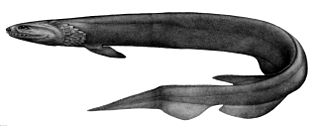
The frilled shark also known as the lizard shark, and the southern African frilled shark are the two extant species of shark in the family Chlamydoselachidae. The frilled shark is considered a living fossil, because of its primitive, anguilliform (eel-like) physical traits, such as a dark-brown color, amphistyly, and a 2.0 m (6.6 ft)–long body, which has dorsal, pelvic, and anal fins located towards the tail. The common name, frilled shark, derives from the fringed appearance of the six pairs of gill slits at the shark's throat.

The Squaliformes are an order of sharks that includes about 126 species in seven families.

The Lamniformes are an order of sharks commonly known as mackerel sharks. It includes some of the most familiar species of sharks, such as the great white, as well as more unusual representatives, such as the goblin shark and megamouth shark.
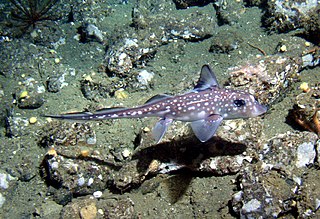
Chimaeras are cartilaginous fish in the order Chimaeriformes, known informally as ghost sharks, rat fish, spookfish, or rabbit fish; the last three names are not to be confused with rattails, Opisthoproctidae, or Siganidae, respectively.
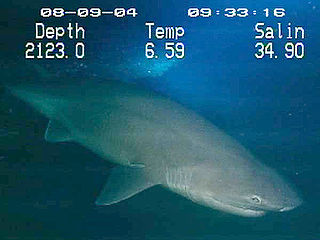
Cow sharks are a shark family, the Hexanchidae, characterized by an additional pair or pairs of gill slits. Its 37 species are placed within the 10 genera: Gladioserratus, Heptranchias, Hexanchus, Notidanodon, Notorynchus, Pachyhexanchus, Paraheptranchias, Pseudonotidanus, Welcommia, and Weltonia.

Elasmobranchii is a subclass of Chondrichthyes or cartilaginous fish, including sharks, rays, skates, and sawfish. Members of this subclass are characterised by having five to seven pairs of gill clefts opening individually to the exterior, rigid dorsal fins and small placoid scales on the skin. The teeth are in several series; the upper jaw is not fused to the cranium, and the lower jaw is articulated with the upper. The details of this jaw anatomy vary between species, and help distinguish the different elasmobranch clades. The pelvic fins in males are modified to create claspers for the transfer of sperm. There is no swim bladder; instead, these fish maintain buoyancy with large livers rich in oil.

The broadnose sevengill shark is the only extant member of the genus Notorynchus, in the family Hexanchidae. It is recognizable because of its seven gill slits, while most shark species have five gill slits, with the exception of the members of the order Hexanchiformes and the sixgill sawshark. This shark has a large, thick body, with a broad head and blunt snout. The top jaw has jagged, cusped teeth and the bottom jaw has comb-shaped teeth. Its single dorsal fin is set far back along the spine towards the caudal fin, and is behind the pelvic fins. In this shark the upper caudal fin is much longer than the lower, and is slightly notched near the tip. Like many sharks, this sevengill is counter-shaded. Its dorsal surface is silver-gray to brown in order to blend with the dark water and substrate when viewed from above. In counter to this, its ventral surface is very pale, blending with the sunlit water when viewed from below. The body and fins are covered in a scattering of small black & white spots. In juveniles, their fins often have white margins.

Chlamydoselachus is a genus of sharks and the sole extant member of the family Chlamydoselachidae, in the order Hexanchiformes. It contains two extant and several extinct species. The most widely known species still surviving is the frilled shark. It is known as a living fossil, along with Chlamydoselachus africana, also known as the southern African frilled shark, which is only found along coastal areas of South Africa. The only two extant species of this genus are deep-sea creatures which are typically weakened in areas closer to the surface.

The bigeyed sixgill shark is a cow shark of the family Hexanchidae. Its dorsal surface has a brownish-gray color, and is sharply separated from the light coloring of its ventral surface. The eyes are a fluorescent green while the shark is alive. The body of this shark is small, slim, and fusiform in shape. As the name suggests, this shark has six gill slits, unusual among most shark species. The head is narrow and somewhat flattened, and the mouth contains 5 rows of large, comb-shaped teeth. This shark's single dorsal fin is pushed back towards the caudal fin, and is behind the pelvic fins. The upper caudal fin is much longer than the lower, with a deep notch near the tip. All fins have thin white margins on the edge. In juveniles, the upper caudal fin has a black tip.

Hybodus is an extinct genus of hybodont, a group of shark-like elasmobranchs that lived from the Late Devonian to the end of the Cretaceous. Species closely related to the type species Hybodus reticulatus lived during the Early Jurassic epoch. Numerous species have been assigned to Hybodus spanning a large period of time, and it is currently considered a wastebasket taxon that is 'broadly polyphyletic' and requires reexamination. The first fossilized teeth from Hybodus were found in England around 1845; since then teeth have been recovered from Europe. During the Triassic, Jurassic, and Cretaceous periods, the hybodonts were especially successful and could be found in shallow seas around the world. For reasons that are not fully understood, the hybodonts became extinct near the end of the Late Cretaceous period.
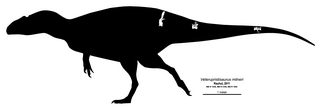
Veterupristisaurus is an extinct genus of carcharodontosaurid theropod dinosaur known from the Jurassic of Tendaguru, Lindi Region of southeastern Tanzania.
Welcommia is an extinct genus of shark. It contains only three species :-
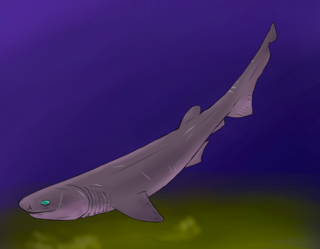
Mcmurdodus is an extinct genus of sharks and the sole member of the family Mcmurdodontidae, in the order Hexanchiformes. It contains two extinct species.

Orthacodontidae is an extinct family of sharks in the order Synechodontiformes. It contains twelve species within three genera. Some authors included it into Hexanchiformes or Lamniformes.

Squalomorphii is a superorder of cartilaginous fishes, generally characterized by lacking traits such as an anal fin, nictitating membrane, or suborbital shelves in the cranium. Squalomorphii sharks are also called squalea, or squalean sharks. There are about 163 living species in 11 families. Squalean sharks are divided into four orders: the Hexanchiformes, Squaliformes, Squatiniformes, and Pristiophoriformes.
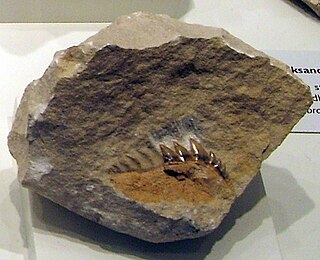
Notidanodon is an extinct genus of cow shark. Fossils ascribed to this genus are known from the Jurassic, Cretaceous, and Paleogene periods. The genus is known from every continent including Antarctica.

Crassodontidanidae is a family of extinct cow sharks that lived from the Early Jurassic to the Early Cretaceous. It contains three genera: Crassodontidanus, Notidanoides, and Pachyhexanchus.
Pseudonotidanidae is an extinct family of prehistoric sharks in the order Hexanchiformes. It was formerly part of the extinct order Synechodontiformes.















